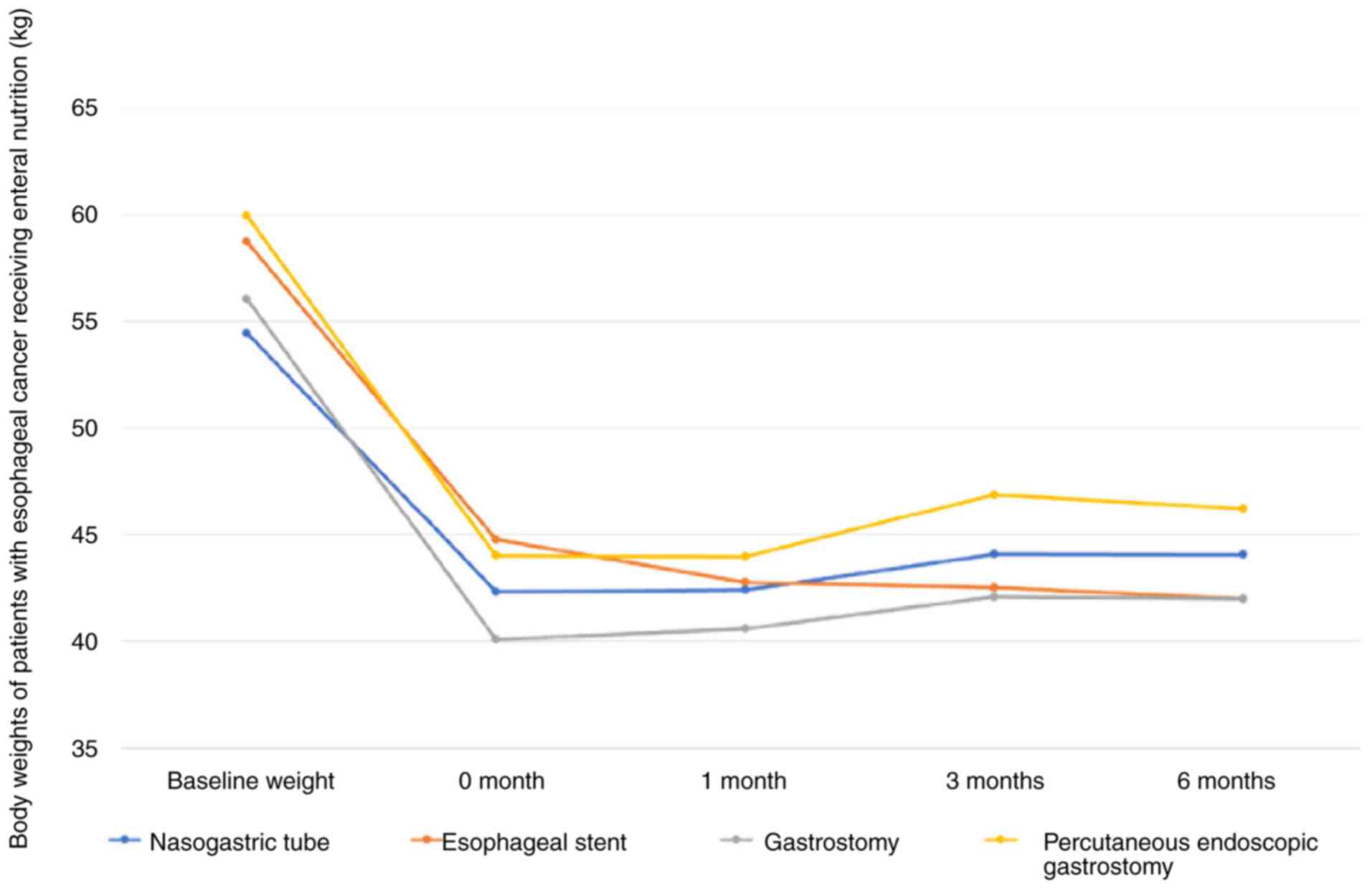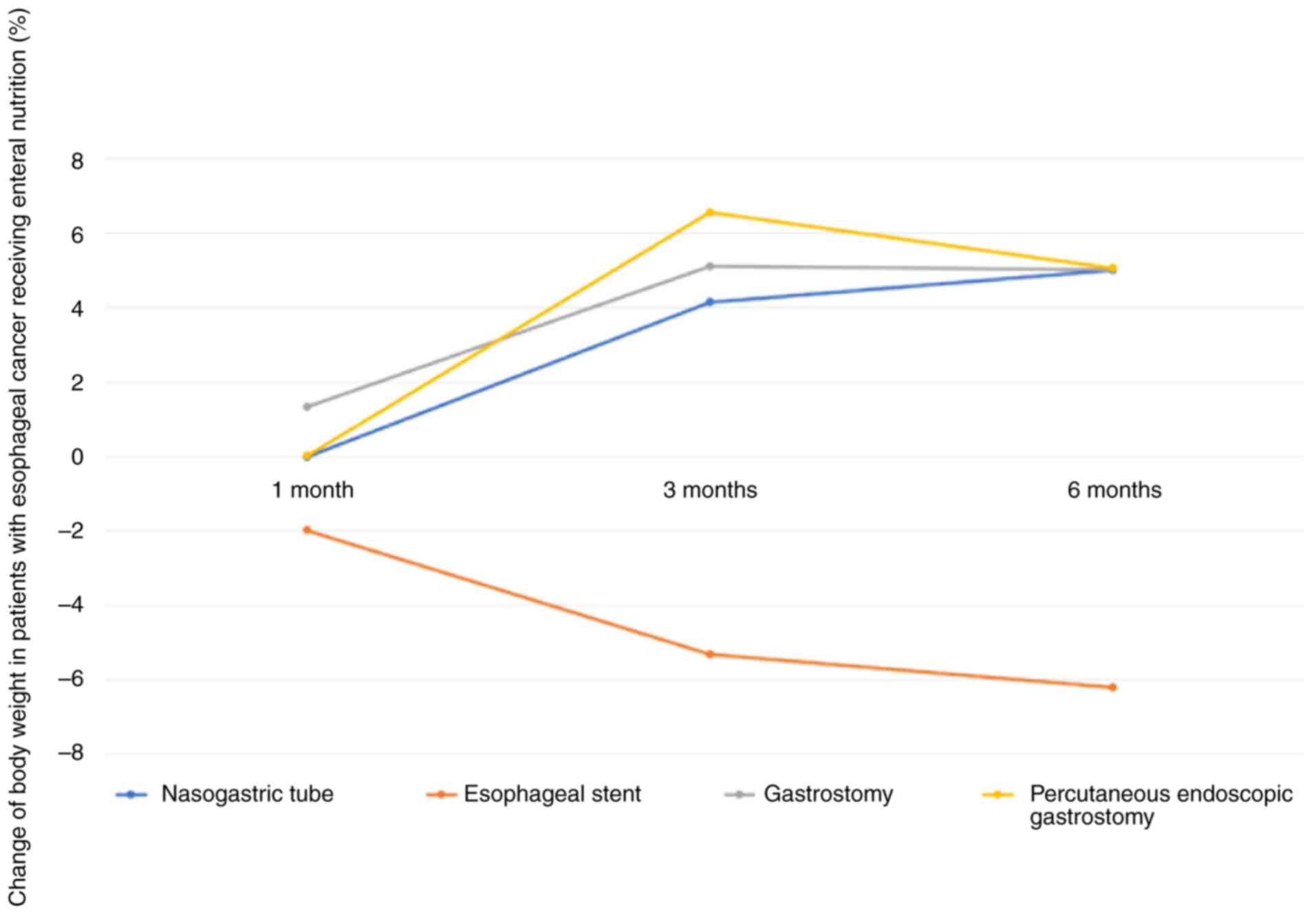|
1
|
Morgan E, Soerjomataram I, Rumgay H,
Coleman HG, Thrift AP, Vignat J, Laversanne M, Ferlay J and Arnold
M: The global landscape of esophageal squamous cell carcinoma and
esophageal adenocarcinoma incidence and mortality in 2020 and
projections to 2040: New estimates from GLOBOCAN 2020.
Gastroenterology. 163:649–658. 2022.PubMed/NCBI View Article : Google Scholar
|
|
2
|
Zhu H, Wang Z, Deng B, Mo M, Wang H, Chen
K, Wu H, Ye T, Wang B, Ai D, et al: Epidemiological landscape of
esophageal cancer in Asia: Results from GLOBOCAN 2020. Thorac
Cancer. 14:992–1003. 2023.PubMed/NCBI View Article : Google Scholar
|
|
3
|
Sunpaweravong S, Benjhawaleemas P,
Karnjanawanichkul O, Yolsuriyanwong K, Ruangsin S, Laohawiriyakamol
S and Chaipetch O: Randomized controlled trial of intravenous
sedation vs general anesthesia for esophageal dilation with
percutaneous endoscopic gastrostomy in esophageal cancer patients.
Surg Endosc. 37:5109–5113. 2023.PubMed/NCBI View Article : Google Scholar
|
|
4
|
Nun-Anan P and Vilaichone RK: Late stage
and grave prognosis of esophageal cancer in Thailand. Asian Pac J
Cancer Prev. 16:1747–1749. 2015.PubMed/NCBI View Article : Google Scholar
|
|
5
|
Ispoglou T, McCullough D, Windle A, Nair
S, Cox N, White H, Burke D, Kanatas A and Prokopidis K: Addressing
cancer anorexia-cachexia in older patients: Potential therapeutic
strategies and molecular pathways. Clin Nutr. 43:552–566.
2024.PubMed/NCBI View Article : Google Scholar
|
|
6
|
Garutti M, Noto C, Pastò B, Cucciniello L,
Alajmo M, Casirati A, Pedrazzoli P, Caccialanza R and Puglisi F:
Nutritional management of oncological symptoms: A comprehensive
review. Nutrients. 15(5068)2023.PubMed/NCBI View Article : Google Scholar
|
|
7
|
Li Y, Pond G, Van Osch A, Reed R, Ung Y,
Cheng S, Menjak I, Doherty M, Moglica E and Taggar AS: Enhancing
nutrition support for esophageal cancer patients: Understanding
factors influencing feeding tube utilization. Nutr Cancer.
76:271–278. 2024.PubMed/NCBI View Article : Google Scholar
|
|
8
|
Akagündüz DD and Türker PF: Nutritional
support in older patients with esophageal cancer undergoing
chemoradiotherapy. Nutr Cancer. 74:3634–3639. 2022.PubMed/NCBI View Article : Google Scholar
|
|
9
|
Salas S, Cottet V, Dossus L, Fassier P,
Ginhac J, Latino-Martel P, Romieu I, Schneider S, Srour B,
Touillaud M, et al: Nutritional Factors during and after cancer:
Impacts on survival and quality of life. Nutrients.
14(2958)2022.PubMed/NCBI View Article : Google Scholar
|
|
10
|
Muscaritoli M, Arends J, Bachmann P,
Baracos V, Barthelemy N, Bertz H, Bozzetti F, Hütterer E, Isenring
E, Kaasa S, et al: ESPEN practical guideline: Clinical nutrition in
cancer. Clin Nutr. 40:2898–2913. 2021.PubMed/NCBI View Article : Google Scholar
|
|
11
|
Mahawongkajit P, Techagumpuch A,
Limpavitayaporn P, Kanlerd A, Sriussadaporn E, Juntong J, Tongyoo A
and Mingmalairak C: Comparison of introducer percutaneous
endoscopic gastrostomy with open gastrostomy in advanced esophageal
cancer patients. Dysphagia. 35:117–120. 2020.PubMed/NCBI View Article : Google Scholar
|
|
12
|
Mahawongkajit P and Techagumpuch A:
Gastrostomy in patients with previous abdominal surgery: A
comparative study between the laparoscopy-assisted introducer
percutaneous endoscopic gastrostomy versus open gastrostomy in
advanced esophageal cancer. Dysphagia. 36:67–72. 2021.PubMed/NCBI View Article : Google Scholar
|
|
13
|
Neacşu F, Vârban AŞ, Simion G, Şurghie R,
Pătraşcu OM, Sajin M, Dumitru M and Vrînceanu D: Lung cancer
mimickers-a case series of seven patients and review of the
literature. Rom J Morphol Embryol. 62:697–704. 2021.PubMed/NCBI View Article : Google Scholar
|
|
14
|
National Comprehensive Cancer Network.
NCCN clinical practice guidelines in oncology: Esophageal and
Esophagogastric junction Cancers, version 4[Internet]. Fort
Washington, PA: National Comprehensive Cancer Network; 2023.
https://www.nccn.org/professionals/physician_gls/pdf/esophageal.pdf.
Accessed Jan 2, 2024.
|
|
15
|
Kitagawa Y, Ishihara R, Ishikawa H, Ito Y,
Oyama T, Oyama T, Kato K, Kato H, Kawakubo H, Kawachi H, et al:
Esophageal cancer practice guidelines 2022 edited by the Japan
esophageal society: Part 1. Esophagus. 20:343–372. 2023.PubMed/NCBI View Article : Google Scholar
|
|
16
|
Kitagawa Y, Ishihara R, Ishikawa H, Ito Y,
Oyama T, Oyama T, Kato K, Kato H, Kawakubo H, Kawachi H, et al:
Esophageal cancer practice guidelines 2022 edited by the Japan
esophageal society: Part 2. Esophagus. 20:373–389. 2023.PubMed/NCBI View Article : Google Scholar
|
|
17
|
Cederholm T, Bosaeus I, Barazzoni R, Bauer
J, Van Gossum A, Klek S, Muscaritoli M, Nyulasi I, Ockenga J,
Schneider SM, et al: Diagnostic criteria for malnutrition-An ESPEN
consensus statement. Clin Nutr. 34:335–340. 2015.PubMed/NCBI View Article : Google Scholar
|
|
18
|
Quyen TC, Angkatavanich J, Thuan TV, Xuan
VV, Tuyen LD and Tu DA: Nutrition assessment and its relationship
with performance and Glasgow prognostic scores in Vietnamese
patients with esophageal cancer. Asia Pac J Clin Nutr. 26:49–58.
2017.PubMed/NCBI View Article : Google Scholar
|
|
19
|
Wiwitkeyoonwong J, Jiarpinitnun C,
Hiranyatheb P and Ngamphaiboon N: Impact of weight loss on patients
with locally advanced esophageal and esophagogastric junction
cancers treated with chemoradiotherapy. Asian Pac J Cancer Prev.
22:3847–3855. 2021.PubMed/NCBI View Article : Google Scholar
|
|
20
|
Wang X, Liu X, Gu Z, Li X and Shu Y:
Experiences and requirements in nutritional management of patients
with esophageal cancer: A systematic review and qualitative
meta-synthesis. Support Care Cancer. 31(633)2023.PubMed/NCBI View Article : Google Scholar
|
|
21
|
Ai X, Zhang P, Xie X, Qiu B, Zhu Y, Zhao
L, Xi M, Wu Y, Guo S, Guo J, et al: Efficacy and cost-effectiveness
analysis of pretreatment percutaneous endoscopic gastrostomy in
unresectable locally advanced esophageal cancer patients treated
with concurrent chemoradiotherapy (GASTO 1059). Cancer Med.
12:15000–15010. 2023.PubMed/NCBI View Article : Google Scholar
|
|
22
|
Lin CH, Liu NJ, Lee CS, Tang JH, Wei KL,
Yang C, Sung KF, Cheng CL, Chiu CT and Chen PC: Nasogastric feeding
tube placement in patients with esophageal cancer: Application of
ultrathin transnasal endoscopy. Gastrointest Endosc. 64:104–107.
2006.PubMed/NCBI View Article : Google Scholar
|
|
23
|
Sasso JGRJ, de Moura DTH, Proença IM,
Junior ESDM, Ribeiro IB, Sánchez-Luna SA, Cheng S, Bestetti AM, Kum
AST, Bernardo WM and de Moura EGH: Anti-reflux versus conventional
self-expanding metal stents in the palliation of esophageal cancer:
A systematic review and meta-analysis. Endosc Int Open.
10:E1406–E1416. 2022.PubMed/NCBI View Article : Google Scholar
|
|
24
|
Chandan S, Mohan BP, Khan SR, Bhogal N,
Canakis A, Bilal M, Dhaliwal AS, Aziz M, Mashiana HS, Singh S, et
al: Clinical efficacy and safety of palliative esophageal stenting
without fluoroscopy: A systematic review and meta-analysis. Endosc
Int Open. 8:E944–E952. 2020.PubMed/NCBI View Article : Google Scholar
|
|
25
|
Mão-de-Ferro S, Serrano M, Ferreira S,
Rosa I, Lage P, Alexandre DP, Freire J, Mirones L, Casaca R,
Bettencourt A and Pereira AD: Stents in patients with esophageal
cancer before chemoradiotherapy: High risk of complications and no
impact on the nutritional status. Eur J Clin Nutr. 70:409–410.
2016.PubMed/NCBI View Article : Google Scholar
|
|
26
|
Yu FJ, Shih HY, Wu CY, Chuang YS, Lee JY,
Li HP, Fang PT, Tsai DL, Chou SH and Wu IC: Enteral nutrition and
quality of life in patients undergoing chemoradiotherapy for
esophageal carcinoma: A comparison of nasogastric tube, esophageal
stent, and ostomy tube feeding. Gastrointest Endosc. 88:21–31.
2018.PubMed/NCBI View Article : Google Scholar
|
|
27
|
Siddiqui AA, Glynn C, Loren D and Kowalski
T: Self-expanding plastic esophageal stents versus jejunostomy
tubes for the maintenance of nutrition during neoadjuvant
chemoradiation therapy in patients with esophageal cancer: A
retrospective study. Dis Esophagus. 22:216–222. 2009.PubMed/NCBI View Article : Google Scholar
|
|
28
|
Smith ZL, Gonzaga JE, Haasler GB, Gore EM
and Dua KS: Self-expanding metal stents improve swallowing and
maintain nutrition during neoadjuvant therapy for esophageal
cancer. Dig Dis Sci. 62:1647–1656. 2017.PubMed/NCBI View Article : Google Scholar
|
|
29
|
Bardol T, Ferre L, Aouinti S, Dupuy M,
Assenat E, Fabre JM, Picot MC and Souche R: Survival after
multimodal treatment including surgery for metastatic esophageal
cancer: A systematic review. Cancers (Basel).
14(3956)2022.PubMed/NCBI View Article : Google Scholar
|











